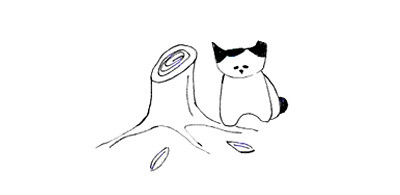Thursday, April 30, 2009
Tuesday, April 28, 2009
The second Singapore Animal Welfare Symposium will take place on Saturday the 16th May 2009 at NUS

home
The date has been set! The second Singapore Animal Welfare Symposium will take place on Saturday the 16th May 2009 at NUS (National University of Singapore), Lecture Theatre 27.
Co-organised and hosted by NUS Animal Welfare Club and ACRES (Animal Concerns Research and Education Society), this year's Symposium is set to be even bigger and better than last years inaugural event!
Lively discussions on the topics of Wild Animals in Entertainment and Domestic Animal Welfare, with panelists from local animal protection groups, will put the spotlight on these pressing concerns and allow all of us who care about animals to discuss how we can successfully address these issues and together come up with effective strategies to end animal exploitation.
This year, exciting presentations will also be made by the 2008 Animal Protectors Grant recipients, showing how they have made a positive difference for animals in Singapore over the past year, and sharing with you how you can make a difference too!
A special “Cruelty-Free Bazaar”, the first of its kind in Singapore, will showcase some of the fantastic products available in Singapore that have not involved any animal suffering.
Come and get your hands on some vegan goodies and treat yourself to some animal-friendly toiletries that have not been tested on animals. All the cruelty-free products you need in one place- an ethical shopper's delight!
Last but not least, the Symposium will see the launch of the 2009 Animal Protectors Grant. Come along and find out how you can apply for the grant and make 2009 the year that your dreams for helping animals come true!
Attendance at the Symposium can be your first step on the way to becoming an advocate for animals, or for those already involved in the animal welfare movement the Symposium is a wonderful opportunity to make new friends with like-minded people, chat to local animal welfare experts and learn more about how you can do even more to help our furred, feathered and scaled friends!
site by lux-solis.net
Go vegetarian - for the earth, for the animals and for humans!
| Do we really need more reasons to go vegetarian? | for everyone |
Each one of us can help prevent animals from suffering in factory farms simply by choosing vegetarian options. It's never been easier to replace animal products with readily available vegetarian alternatives.
Go vegetarian -
for the earth, for the animals and for humans!

Swine Flu and Factory Farms: Fast Track to Disaster
http://www.humanesociety.org/farm/news/ournews/swine_flu.html
Healthy trees in Pasir Ris get chopped down
MY SAY




Healthy trees in Pasir Ris get chopped down
IT WAS reported that the temperature in Singapore was above 35 deg C on April 18.
Everyone everywhere is complaining all the time about how hot the weather is.
However, little do they know that we humans are the cause.
I live in Block 580, Pasir Ris Street 53. It used to be clean and green, and I could see beautiful trees outside my window.
I would tell my children that it is thanks to the trees that we have fresh air and shade.
My son knows that the evaporation from a single large tree produces the cooling effect of 10 air-conditioning units.
Many adults do not know this fact and neither does the Pasir Ris Town Council.
I say this because town-councilworkers have been cutting down healthy trees in my estate, despite my appeals to the contrary.
My daughter asked why “naughty workers” were cutting down the trees which she had known since she was young. She asked if they were “sick”.
How could I explain to her that humans sometimes destroy things for their own convenience?
We do not own this planet – we share it with all living things, including trees.
Without trees, humans cannot survive.
Sometimes, I wish the trees could rise up against humans, just like in the movie, The Lord Of The Rings.
I appeal to the town council to stop cutting down healthy trees. Save our trees and save the human race.
Ms Alice Tan Zhen Zhi
Monday, April 27, 2009
I Love Singapore: Secular & Multi-Religious
Sunday, April 26, 2009
Logos for a Secular Singapore
Friday, April 24, 2009
Fast Cities: Cat Lady Edition
Fast Cities: Cat Lady Edition

Fast Cities: Cat Lady Edition

Every year we publish our Fast Cities package [0] devoted to the most creative cities. Sadly, this year we weren't able to answer one pressing question: Which places are best for cats? Well you're in luck. CATalyst Council--a non-profit coalition that represents veterinaries and animal shelters, among others--just did such a study and has released a list of the 10 best cities for cats: Tampa, Phoenix, San Francisco, Portland (Oregon), Denver, Boston, Seattle, San Diego, Atlanta, and Minneapolis.
The CATalyst Council's ratings combined several factors, including cat ownership rates, vet quality, microchipping and "cat-friendly" city ordinances. Surely, these would also be the places where cat ladies dwell. Not even close! According to the U.S. Census, these cities have an overwhelming surplus of never-married men, versus never-married women:

Initially, we were bummed that the cat-lady cliche was not proven by the data from the U.S. Census as the CATalyst Council. But then we realized: There's a dating strategy here, for any cat lady or cat-lady-in-the-making. If you find yourself meeting more cats than men, you should move to any one of the cities above. Not only do they suit cats, but they've got a huge population of unmarried men, just waiting for a good woman. And a few extra kitties are fine.
Taxi driver hits dog but ignores pleas to help

Thu, Apr 23, 2009
The New Paper
Taxi driver hits dog but ignores pleas to help
FOR nine years they took care of their pet dog, doting over it like a child.
It happened on 11 Apr, when Miss Wong Fang Juin, 36, a civil servant, was about to take her Maltese called Blanc, to see the vet for a skin condition.
Miss Wong said: 'I forgot my handphone and I went to get it. I tied up Blanc but somehow he wriggled free and headed for the road.
'Suddenly I heard loud sounds and people shouting. By the time I ran to the road, I saw our dog dead and the taxi escaping.'
Blanc had been cared for by Miss Wong and Ms Ashton Ooi, 43, a pet shop owner, since it was a puppy.
They were not able to find owners for it because it had a bad skin condition.
When Blanc went past a coffee shop at Jalan Legundi that morning, coffee shop owner Tan Yew Huat, 52, saw it and commented to his colleague about how cute it was.
Said Mr Tan: 'Then an NTUC Comfort cab turned from the carpark and ran over it. When the first wheel hit the dog, I gestured to the driver to stop.
'The dog was struggling to get up but the cabby drove on. When the second wheel hit the dog, the dog became motionless.
'The driver shrugged but did not stop.'
Mr Tan ran after the taxi and managed to reach it when it stopped at a road junction roughly 40 metres away.
'I opened the car door and told him that he ran over a dog and should be responsible and do something about it.
'He agreed and told me he would turn around, but he sped off,' said Mr Tan.
Miss Wong said: 'If he had stopped when the wheel first hit him, I think our dog would still be alive.'
Mr Tan said he had shouted so loudly that even the people who were renovating a shop a few doors away from his coffee shop heard him.
'How could he not have heard or seen anything? I really pity the dog,' he said.
The vet report said the dog is likely to have died from head trauma from a fractured skull.
Miss Wong, who said she has had difficulty sleeping or eating since the incident, said: 'Basically, his skull just wasn't there any more, his head was crushed by the back wheel.
Clear view
'If it had been the front wheel, he would not have moved after being hit, but the eyewitness saw him moving, so it must have been the second wheel that killed him.'
Ms Ooi said: 'An accident like this should not have happened. It occurred when the driver was turning out of the carpark with a clear view of the opposite road.'
With information from eyewitnesses who took down the cabby's plate number, Ms Ooi lodged a police report.
Under the Road Traffic Act, the driver of a vehicle that is involved in a road accident where damage or injury is caused to any person, vehicle, structure or animal, has to report the accident at a police station or to a police officer within 24 hours.
Any person who fails to comply will be guilty of an offence.
She wants to take legal action against the driver for being reckless.
| READ MORE - Hitting animal as serious as hitting a human |
She wrote to ComfortDelGro, saying: 'He obviously did not check the road before turning out and even after knowing he had run over my dog, he did not have the basic courtesy and humanity to get down and render assistance.
'In spite of agreeing to deal with the situation, he fled. As I understand under Section 84 of the Road Traffic Act, it is an offence to hit and run.'
Replying, Ms Tammy Tan, group corporate communications officer for ComfortDelGro Corporation, told Ms Ooi and The New Paper: 'We are very sorry that Ms Ooi lost her dog as a result of an accident with our taxi.
'We have conducted a detailed investigation into the matter, including speaking to independent witnesses. Based on our findings, we have found that Ms Ooi's dog had broken free of its leash without her knowledge and run down Jalan Legundi unattended.
'Our taxi was turning into that road at the time and accidentally hit Ms Ooi's dog. Our driver was initially unaware that an accident had taken place.'
After he was told by a member of the public, he should have stopped and rendered assistance, she said.
For not doing so, he has been given a 'very stern warning and will be monitored closely'.
Ms Tan added: 'We are currently in contact with Ms Ooi and we will assist the Traffic Police in their investigations. The driver has since expressed his remorse for hitting the dog.'
Ms Ooi said: 'How remorseful can he be? He has not contacted us directly so far after so many days.'

This article was first published in The New Paper.
New quarantine rules soon, says AVA
April 24, 2009
New quarantine rules soon, says AVA
I REFER to the Forum Online letter, 'Ease up on rigid quarantine rules for pets' (April 10).
The Agri-Food and Veterinary Authority (AVA) is responsible for safeguarding animal and public health in Singapore from the introduction of animal diseases.
One important animal disease is rabies. Rabies is a fatal disease in both animals and humans. Hence, the AVA treats the prevention of rabies incursion into Singapore very seriously.
The requirement to quarantine imported dogs and cats is part of our risk management approach for this disease. This risk management approach has kept Singapore free from rabies since 1953.
At the same time, we regularly review our risk management measures to keep in line with developments in science and technology. We are pleased to inform you that the AVA will implement a new set of import and quarantine requirements as part of our risk management approach to the import of dogs and cats into Singapore. AVA has forwarded a notification on the new import and quarantine requirements to the World Trade Organisation (WTO) for comments by exporting countries, in accordance with our WTO obligation.
The AVA aims to implement the new quarantine policy from Jan 1 next year. Readers may find more details at the following links:
docsonline.wto.org/DDFDocuments/t/g/sps/NSGP36A1.doc
docsonline.wto.org/DDFDocuments/t/g/sps/NSGP37.doc
Goh Shih Yong
Assistant Director, Corporate Communications
for Chief Executive Officer
Agri-Food and Veterinary Authority
Thursday, April 23, 2009
Book “Pawprints on my heart” by Chan Kah Yein, Ph.D.

Book “Pawprints on my heart” by Chan Kah Yein, Ph.D.
Download the attached book in PDF format.
Wednesday, April 22, 2009
World Animal Day - 4 October
World Animal Day - 4 October
Although it’s only April, now is the time to start thinking about how you’re going to celebrate World Animal Day this year. Even if you don’t have a lot of spare time, we've got plenty of fundraising / educational ideas that don’t take much organising and, by starting to think about it now you can spread the workload. Also, if you enlist plenty of help the sky’s the limit! Click on Get Involved NOW! Please help us spread the word about World Animal Day by including information in a newsletter and/or by creating a website link. Full instructions for a number of different styles of weblink are available in the ‘Resources’ section of the website where you will also find the World Animal Day logo in various formats. |
Events were held in 66 countries in celebration of World Animal Day 2008 |
This Slide Show will give you a 'taste' of just how great World Animal Day 2008 was!
|
'Click' on the links to read Worldwide Event Reports and view images |
Monday, April 20, 2009
Story of Gym-Mee now called Zacky
He was so affectionate that the staff and many users came to love him, and that put his life in danger, because he came to settle himself at the entrance of the fitness centre, awaiting for a loving pat on the head as users walked in and out.
One day, a lady-user who has phobia of cats, filed a complaint with the management even though the staff accomodated her phobia by opening a side entrance for her.
She gave an ultimatum for the cat's "removal" or she would complain to "higher authorities".
The management contacted AVA and fortunately the AVA officer managed to contact a caregiver in the vicinity of the fitness centre.
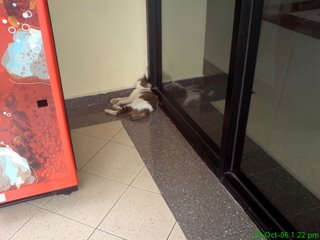
Photos taken on 19th October 2006
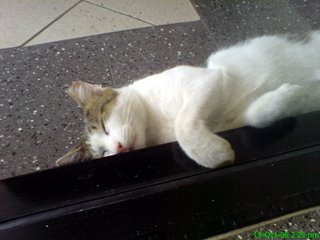
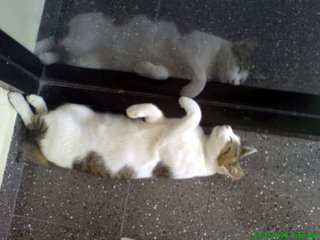
As the life of Gym-Mee was in too much danger from just ONE complainant, he was moved to a shelter where he was adopted on 17th Novembe 2006.
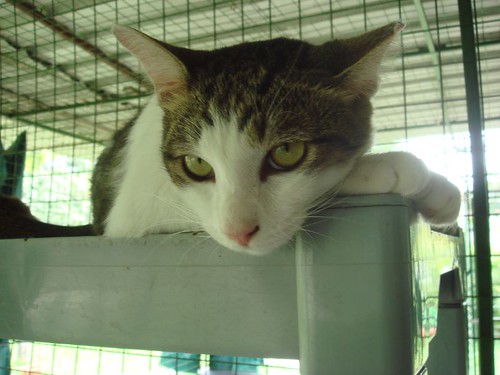
16th November 2006: in the shelter.
He now lives in a private apartment in a classy district! He is now called Zacky.
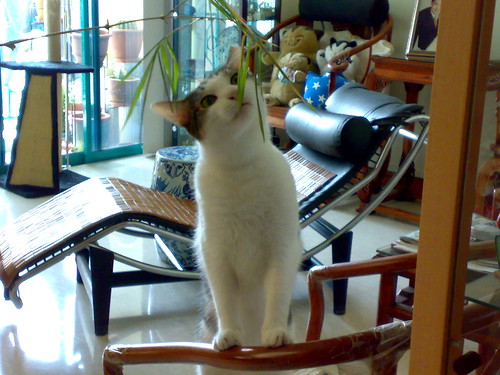

18th April 2009, blog's entry, "Zacky has decided, as part of an important member of the household, to guard expensive electronic equipment, wherever that equipment maybe, toilet or otherwise"
Collars and your pet
Many clients put collars around the neck of their pet dog or cat. A collar serves a useful purpose by providing a visible means of identification if it has an identification tag, municipal licence number, or rabies tag number attached to it. However, a poorly fitted collar can cause potentially serious problems. Veterinarians routinely see problems that are associated with improperly sized collars – problems occur when the collar is either too tight or too loose.
The problem with a collar being too tight is somewhat obvious – if the collar is too tight, it can cause irritation, pressure sores, or in the worst-case scenario, difficulty breathing. Most often, this problem occurs with rapidly growing puppies that outgrow their first collar within a few weeks. The fact that the collar has become too tight may be less noticeable if the puppy has a long haircoat.
A collar that is too loose may cause serious harm. The most obvious problem associated with a collar being too loose is that it can easily slip off during a walk, allowing the pet to run off unrestrained and get into an automobile accident. A less obvious but more serious problem occurs in pets that are allowed to go outdoors unsupervised. If the collar is only slightly loose, the pet can get a paw up between the collar and its neck, often in an attempt to remove the collar. The paw then gets stuck in the collar, and the pet continues its struggle to remove the offending collar. Depending on the type of collar, it may stretch enough to allow the animal to pass its whole leg through the collar, with the ultimate result being that the collar becomes lodged beneath the axilla or armpit. Although the average person may think that this is unlikely to happen, it occurs more often than you might think. Many veterinary practices have had to treat an injured pet, usually a cat, with skin wounds caused by a collar that has become trapped around a portion of its body. The severity of the wounds depends largely on the length of time that the collar has been stuck around the body part, but in many cases, surgical intervention is required as part of the treatment.
So, how should a collar fit your pet?
First, the collar should be put on tightly enough so that it won’t slip over the pet’s head. It should be tight enough to prevent the pet from getting his or her paw between the collar and neck. The actual degree of tightness will depend on the size of the pet, since a cat’s paw is obviously much smaller than a retriever’s paw. Second, when you first put a collar on your pet, recognize that it may react with fright or annoyance – many animals will attempt to immediately remove the collar. The prudent person will ensure that the first time a collar is put on their pet, he or she cannot run away, and most importantly, cannot escape outdoors. Thirdly, you should check the fit of your pet’s collar, as well as checking it for wear and tear, on at least a weekly basis for a puppy or kitten, or a monthly for an adult pet. Finally, because cats have a tendency to jump up onto high perches, and love to climb trees, your cat should only wear a collar that is designed to break-away if it gets caught.
Adopters who lie
Someone expressed interest in adoption and she said her window and door grills were meshed.
Being "seasoned" fosterer, my friend said that she would personally deliver the kitten to the potential adopter's home.
The grills were NOT meshed.
After spending two hours explaining the dangers of grills large enough for the kitten to squeeze out and fall to its death or severe injuries, resulting even in paralysis, the adopter's husband rejected meshing. The fosterer even brought along the wire mesh.
Perhaps it is a good thing that adopter was "truthful" during the face-to-face meeting, for she or her husband could easily have removed the wire mesh later.
Fosterer took the kitten home.
Lessons to be learnt here
1) MAKE A HOME VISIT to meet the adopters personally and to assess the home.
2) MAKE UNANNOUNCED VISIT if the wire mesh is just put up on the day adoption.
3) REJECT any refusal for a home visit.
Sunday, April 19, 2009
Should I Assess for Animal Cruelty as Part of All Routine Child Health Visits?
During a routine check-up, the father of a 4-year-old laughingly told me his son pulls the wings off butterflies. I know that there is a connection between animal cruelty and human violence, but are interventions really necessary for this child who is just harming insects?
 Response from Mary E. Muscari, PhD, CPNP, APRN-BC
Response from Mary E. Muscari, PhD, CPNP, APRN-BC Associate Professor and Director, O'Connor Office for Rural Studies, Decker School of Nursing, Binghamton University, Binghamton, New York
Animal cruelty is one of the earliest and most reliable predictors of later violent behavior, particularly if the child exhibits direct involvement in the cruelty, lack of remorse, engagement in a variety of cruel acts, victimization of different species, and/or mistreatment of valued animals such as dogs.[1] Although many animal-abusing children grow up to be nonviolent, most of the school shooters, including Eric Harris and Dylan Klebold of Columbine High School, had histories of animal cruelty, as did many serial killers.
Assessing for animal cruelty should be part of all routine child health visits, as well as episodic visits when children present with aggressive behaviors or signs of child abuse. Asking the age of the household pets may prove significant, as abused pets rarely live past 2 years because they get killed, die of neglect, or run away to escape the abuse. At the very least, in homes where this constant turnover takes place, children suffer from repeated cycles of attachment and loss.[1]
Formal assessment protocols are in their formative stage of development. In the interim, nurse practitioners can use questions adapted from the Boat Inventory of Animal-Related Experiences,[2] which can be integrated easily into the psychosocial history:
-
Do you have any pets or other animals in your house?
-
What kind? What are their names? How old are they?
-
Who takes care of [the pet/animal]?
-
Have you ever lost a pet/animal you cared about?
-
Do you worry that something bad will happen to [the pet/ animal]?
-
Does anyone ever hurt [the pet/ animal]? Who? How was [the pet/animal] hurt?
-
If an animal has been abused and/or if there is a question of child abuse in the family, ask: "Has anyone ever touched [the pet/ animal] sexually or had sex with [the pet/animal]? Who? What did [the person] do to the pet/animal?"
All episodes of cruelty, even those done out of curiosity, warrant intervention. Definitive classifications and treatment protocols have yet to be developed. However, Ascione[3] created a typology with suggested interventions that can serve as baseline for NPs:
-
Exploratory/curious animal abusers are typically preschoolers or very early school-age children who lack training on the physical care and humane treatment of animals. Developmentally delayed children may also fit into this category. Humane education tends to be sufficient intervention. However, age should not be the only determining factor since animal cruelty is the earliest sign of conduct disorder.
-
Pathological animal abusers are usually, but not necessarily, older. These children may demonstrate symptoms of psychological disturbances of varying severity, and/or may have a history of physical abuse, sexual abuse, or exposure to domestic violence. Professional counseling is warranted.
-
Delinquent animal abusers tend to be adolescents with other antisocial behaviors, sometimes drug-, gang-, or cult-related. Both clinical and judicial interventions may be required.
A 4-year-old who pulls the wings off butterflies may be classified as an exploratory/curious abuser if he has no awareness of the implications of his actions, does not take pleasure in the behavior, and shows some remorse. However, if a parent finds cruel behavior humorous, further family assessment is necessary to assure that violent values and behaviors are not part of the household.
Today's Cry - Susan Boyle, Cat Lady, Dreams a Dream and Makes Us Weepy
Today's Cry - Susan Boyle, Cat Lady, Dreams a Dream and Makes Us Weepy
A 48-year-old, unemployed, self-proclaimed "cat lady" doesn't quite sound like the type of slicked vixen primed for pop superstardom. But on Britain's Got Talent (America's Got Talent's English forefather, starring Simon Cowell), Susan Boyle proved particularly nasty naysayers (including an audience of eye-rolling jerkfaces) wrong with her epic take on "I Dreamed A Dream" from Les Miserables.
Sure, it's an overly-produced, wholly-calculated moment of goopy television, but we'd be lying if we didn't say it brought a tear to our eye. Susan Boyle, you'd better remember all the little people your cats when you hit the big time. We're rooting for you!
Susan Boyle makes us rethink the "spinster cat lady"
Susan Boyle makes us rethink the “spinster cat lady”
 I was in the shower this morning singing the song that’s been stuck in my head for days: “I Dreamed a Dream” from Les Miserables. That’s what you get, I thought, when you watch the Susan Boyle video from Britain’s Got Talent 15 times in three days.
I was in the shower this morning singing the song that’s been stuck in my head for days: “I Dreamed a Dream” from Les Miserables. That’s what you get, I thought, when you watch the Susan Boyle video from Britain’s Got Talent 15 times in three days.
As I’m singing (badly), I hear my cat Phoebe on the other side of the shower curtain begin to meow along to the song.
This must be our way of cheering for the 47-year-old Internet sensation (pictured). Associated Press may describe her this way: ”Susan Boyle lives alone in a row house with her cat Pebbles, a drab existence in one of Scotland’s poorest regions.”
But we single women with cats know what a bum rap that is. Now thanks to Susan Boyle, millions of people around the world do too.
Photo by Associated Press/Andrew Milligan
Singapore Animal Welfare Symposium 2009
Singapore Animal Welfare Symposium 2009
| Host: | |
| Type: | |
| Network: | Global |
| Date: | 16 May 2009 |
| Time: | 08:30 - 17:00 |
| Location: | National University of Singapore. Lecture Theatre 27. Faculty of Science |
| Email: |
Description
The inaugural Singapore Animal Welfare Symposium (SAWS) in 2008 achieved its objectives of educating the public about animal welfare issues and helping groups to realize their animal welfare dreams. The symposium drew a wide range of audience from various backgrounds. This included representatives from more than ten animal welfare interest groups in Singapore.
One of the highlights of last year’s symposium was the awarding of grants to eight different groups to help them realize their animal welfare dreams. These eight projects have been ongoing for the past year and have been benefiting animals in Singapore. The results of these projects will be presented at SAWS 2009.
SAWS 2008 and the Animal Protectors’ Grant received widespread media coverage. This included articles published in The Straits Times and Today, as well as airtime on Channel NewsAsia.
We wish to build upon this success in SAWS 2009. The Symposium will be a platform for the various animal interest groups and all other animal-related organisations to convene and discuss issues, ranging from public education to the philosophical motivation for animal rights.
Furthermore, the Symposium seeks to facilitate better
communication and working relations between the participating organisations, in furtherance of animal welfare in Singapore. Being a national level event, we are aiming to once again engage all animal related groups and involve Singaporeans from all walks of life. Moreover we will be giving out more grants this year to interested and capable groups that will undertake projects to benefit animal welfare.
We look forward to your participation and hope you can contribute to the lively and productive discussion we hope to achieve.
With your support, we hope that animals in Singapore will have a brighter and better tomorrow.
Programme
Registration: 8.30-9.00
Delegates to be seated: 9.00-9.15
Arrival of GOH, Opening Speeches by ACRES and GOH : 9.15-9.30
9.30-11.00
Session 1: Wildlife Protection
Chaired by ACRES, Louis Ng
Panelist: ACRES, AVA, Sea Shepherd, ICA, STOC, Eu Yang Sang, NParks, RMBR, NSS, VSS, SEC.
Overview: Wildlife in the entertainment industry
11.00-11.30
Tea break
11.30-13.30
Session 2: Domestic Animals
Chaired by NUS Animal Welfare
Panelist: ASD, CWS, SPCA, ALL, NANAS, SOS Animals, HRSS, Mutts and Mitten, AVA.
Overview: The major issues in the domestic animal scene
13.30-14.30
Lunch
14.30-15.00
Grant Presentation
15.00-16.00
Public Forum & Closing Address: NUS Animal Welfare Group
Shuttle service will be provided at 8 AM from Buona Viista MRT to the venue on a first come first serve basis.
Saturday, April 18, 2009
We don't need bloodcurdling experiences in supermarkets
STForum Online
April 18, 2009
We don't need bloodcurdling experiences in supermarkets
I APPLAUD yesterday's letter by animal activists, 'Stop live animal sales, urge activists'.
I have started to avoid the Sheng Siong outlet near my home as I find it disturbing to see animals slaughtered right before my eyes.
I agree with Mr Howard Shaw that often, these animals are kept in inhumane conditions. I have also seen crabs and frogs kept in crowded cages at coffee shops, left without food and water for days until they are slaughtered.
I wonder if humans would like to be treated like this before they die?
Do animals suffer less pain because they cannot talk and protest against such treatment? No. The least we can do is to ensure that they are treated humanely until they are killed.
By bringing slaughtering back to the supermarkets, are we regressing to the old days of the wet markets in the 1970s?
These were times when chickens and ducks were kept in sordid conditions and slaughtered daily. Surely, we do not need that. Or are we trying to emulate the open-air markets in China where different kinds of animals can be bought and slaughtered if consumers so wish?
Singapore is progressing. Let us progress in our treatment of animals as well. We do not need bloodcurdling shopping experiences in supermarkets.
Elizabeth Ng (Mrs)
Live sales: No problem so long as animals aren't endangered species
STForum Online
April 18, 2009
Live sales: No problem so long as animals aren't endangered species
I REFER to yesterday's letter by Mr Howard Shaw, 'Stop live animal sales, urge activists', and disagree with the view that the sale and consumption of live seafood pose ethical, environmental and economic problems beyond the initial impression of having a convenient source of fresh seafood.
The unfortunate truth is that if the human race has to eat to live, we have to kill animals from land and sea to survive. We cannot live on rice and vegetables alone. We cannot ignore the fact that fresh meats are more nutritious than frozen ones.
It is strange to consider the consumption of live frogs, soft-shell turtles, razor clams and eels as posing ethical and environmental problems, when we should logically consider them as complementary to live fish, prawns and other live animals. The increasing trend of more variety of live seafood made available is purely due to better transport and handling systems and business acumen of bosses.
I do not see a threat to local businesses like wet markets when most if not all food is imported. Importing from countries of abundance helps to balance the food chains and the ecosystem. In fact, killing whales and sharks is one of nature's ways to maintain the eco-balance because their consumption of sea creatures is horrendous.
If live animals sold in supermarkets are not endangered species, there is no reason to stop introducing better service to customers to complement the supply of wet markets. Yes, live animals should be kept in clean and non-crowded environments to prevent cruelty. Also, the slaughter of live animals in supermarkets should be more discreet and done behind the counter, out of sight of customers, and meat should be thoroughly cleaned before delivery.
Paul Chan
Latest comments
Quote:
Certain religious people (Buddhist monks, Christians fasting for Lent), vegetarians etc - who don't eat meat - aren't part of the human race? Quote:
Quote:
Quote:
Quote:
Quote:
Quote:
| |||||||
Posted by: unewolke at Sat Apr 18 06:19:26 SGT 2009 |
Friday, April 17, 2009
Geylang Serai needs cats not pest controllers with glue traps!

Holly scares the rodents away at home, a deli in Williamsburg, Brooklyn.

Oreo roams at a deli in Greenpoint, Brooklyn.
December 21, 2007
To Dismay of Inspectors, Prowling Cats Keep Rodents on the Run at City Delis
By KATE HAMMER
Across the city, delis and bodegas are a familiar and vital part of the streetscape, modest places where customers can pick up necessities, a container of milk, a can of soup, a loaf of bread.
Amid the goods found in the stores, there is one thing that many owners and employees say they cannot do without: their cats. And it goes beyond cuddly companionship. These cats are workers, tireless and enthusiastic hunters of unwanted vermin, and they typically do a far better job than exterminators and poisons.
When a bodega cat is on the prowl, workers say, rats and mice vanish.
That is the case at a narrow corner store in Williamsburg, Brooklyn, where a gray long-haired tabby named Halloween goes on regular patrols when she is not lounging on a plaid bed tucked behind dusty rows of Schweppes ginger ale and empty cardboard boxes.
“In the morning she is lazy, it is her nap time,” said Urszula Jawor, 49, the deli’s manager, a Polish immigrant who smiled with motherly pride at Halloween, adding that the cat was named for the day she wandered in off the street and claimed the Bedford Avenue store as her home.
“But in the afternoon she is busy,” Ms. Jawor said. “She spends hours stalking the mice and the rats.”
To store owners, the services of cats are indispensable in a city where the rodent problem is serious enough to be documented in a still popular two-minute video clip on YouTube from late February (youtube.com/watch?v=su0U37w2tws) of rats running amok in a KFC/Taco Bell in Greenwich Village. Store-dwelling cats are so common that there is a Web site, workingclasscats.com, dedicated to telling their tales.
But as efficient as the cats may be, their presence in stores can lead to legal trouble. The city’s health code and state law forbid animals in places where food or beverages are sold for human consumption. Fines range from $300 for a first offense to $2,000 or higher for subsequent offenses.
“Any animal around food presents a food contamination threat,” said Robert M. Corrigan, a rodentologist and research scientist for the New York City Department of Health and Mental Hygiene. “And so that means anything from animal pieces and parts to hair and excrement could end up in food, and that alone, of course, is a violation of the health code.”
Mr. Corrigan did concede that some studies have shown that the smell of cats in an enclosed area will keep mice away. But he does not endorse cats as a form of pest control because, he explained, the bacteria, viruses, fungi, parasites and nematodes carried by rats may infect humans by secondary transfer through a cat.
Still, many store owners keep cats despite the law, mainly because other options have failed and the fine for rodent feces is also $300. “It’s hard for bodega owners because they’re not supposed to have a cat, but they’re also not supposed to have rats,” said José Fernández, the president of the Bodega Association of the United States.
Luis Martinez, 42, has managed his brother’s grocery in East New York, Brooklyn, for two years. At first, despite weekly visits from an exterminator, the store’s inventory was ravaged constantly by nibbling vermin.
“Every night I had to put the bread in the freezer,” he said, pointing at shelves filled with bread and hamburger buns. “I was losing too much inventory. The chips and the Lipton soups all had holes in them.”
Then, last winter, a friend brought Mr. Martinez a marmalade kitten in need of a home. Mr. Martinez, who was skeptical of how one slinky kitten could fend off an army of hungry rats, set up a litter box in the back of the store, put down an old fleece jacket and named the kitten Junior.
Within two weeks, Mr. Martinez said, “a miracle.”
“Before you’d see giant rats running in off the streets into the store, but since Junior, no more,” he said.
Junior sometimes brings Mr. Martinez mouse carcasses as gifts, which he said bothers him less than the smell that permeates his store when the exterminator’s victims die and rot under a freezer.
In October, a health inspector fined Mr. Martinez $300 and warned him that if Junior was still there by the time of the next inspection he would be fined $2,000.
“He wants me to get rid of the cat, but the rats will take over if I do,” Mr. Martinez said. “I need the cat, and the cat needs a home.”
Because stores do not get advance notification of an inspection, Mr. Martinez is trying to keep Junior in his office as much as possible. Many bodega owners reason that a cat is less of a health threat than an army of nibbling rats. “If cats live in homes and apartments where people have food, a cat shouldn’t be a threat in a store if it’s well maintained,” Mr. Fernández said.
Some animal rescue groups, like the Spay and Neuter Intervention Project, support the legalization and regulation of store cats so that owners would be required to provide basic veterinary care and to spay or neuter their animals.
At a corner store in Greenpoint, Brooklyn, Andre Duran, one of the owners, said he had kept a cat for six years and had never been fined.
“That’s Oreo,” he said, as he lifted a tiny black cat with white paws into his arms and carried her like a football. “No one’s ever complained about cat hair in their sandwiches, and if she weren’t here, you bet there’d be bigger problems than hair.”
As a line formed at Mr. Duran’s cash register and he excused himself to take orders, Oreo’s ears perked up and she slunk away toward the back of the store. She was, perhaps, in pursuit of something.
Cat Blogging and Blogging Cats
After pornography, cats are possibly the most popular subject matter on the internet. They’re cute, they can be really funny, and most internet users have at least one of their own. Blogs are an easy way to bring more cat content to internet users on a regular basis.
Stop the live slaughter at supermarkets
STForum Online
April 17, 2009
Stop the live slaughter at supermarkets
I REFER to last Saturday's report, 'Supermarkets go live'.
It goes against reason that some supermarkets are allowed to keep live produce that is slaughtered on site for sale.
More than a decade has passed since live slaughtering was prohibited in wet markets. I believe the reasoning then was that blood and offal residue discharged into sewerage systems could lead to severe clogging and the threat of disease. Abattoirs with specialised facilities to handle the waste were developed at considerable cost.
The Agri-Food and Veterinary Authority and the National Environment Agency should curtail this trend of supermarket slaughter.
Errol Goodenough
Stop live animal sales, urge activists
ST Forum
April 17, 2009
Stop live animal sales, urge activists
I REFER to last Saturday's article, 'Supermarkets go live', which describes how the sale of live animals like razor clams, soft-shell turtles and eels is becoming increasingly common in Singapore.
This is a disheartening trend; such practices have serious environmental, ecological and ethical disadvantages. We would like to draw the attention of retailers and consumers to these issues.
The humane slaughter of animals is a carefully regulated process, but with the widespread sale of live animals in supermarkets, it becomes increasingly difficult to monitor and enforce these regulations.
While regulatory efforts are in place, there is no guarantee of humane killing of these animals.
Even where slaughtering practices abide by the guidelines, the conditions these animals are kept in are often overcrowded and unclean. Hence, the SPCA has appealed to the authorities since 2001 to stop unregulated slaughter, and relies on public feedback to aid its efforts.
Increased sales of exotic animals such as soft-shell turtles and razor clams also increase the total volume of live animals imported into Singapore.
While the animals currently imported are not endangered or threatened species, the growth in international trade of animals certainly paves the path for more 'exotic' and possibly endangered types of animals to be brought in. According to WWF-World Wide Fund for Nature, this would encourage the illegal wildlife trade, threatening more species with extinction.
Demand for and sale of live animals are also environmentally and economically unsustainable. Exotic seafood is flown in from numerous countries, including Myanmar, Norway, Australia and Canada. The ecological footprint of these exotic foods is therefore high. Consuming such food regularly has a negative environmental impact in the long run. Local businesses like wet markets are also suffering due to rising demand for imported exotic seafood.
Sale and consumption of live seafood pose ethical, environmental and economic problems beyond the initial impression of having a convenient source of fresh seafood. It is important to teach values of conservation and respect for nature in future generations.
If this worrying trend continues, it is likely that society will become increasingly desensitised to practices such as exploitation of exotic animal species, and cruelty to animals.
With this letter, we wish to stress the importance of shopping responsibly to minimise the negative impact of our choices.
Howard Shaw
on behalf of Singapore Environment Council, Animal Concerns Research and Education Society, WWF-World Wide Fund for Nature (Singapore) and Society for the Prevention of Cruelty to Animals
Thursday, April 16, 2009
Ban supermarkets from selling live and exotic animals
April 16, 2009
Ban supermarkets from selling live and exotic animals
I WAS shocked and dismayed by the report, 'Supermarkets go live' (April 11). Eating meat, especially from animals reared under intense industrial farming methods, is inhumane as it subjects animals to intense cruelty, apart from abuse of hormones and antibiotics used on them.
Going for exotic wild species like bullfrogs and turtles is even worse, as one is plucking them directly from their natural ecosystems and creating a major imbalance. By making it easy and convenient for consumers, supermarkets only create easy demand, and more pressure to harvest more in future, beyond sustainable capacities of the environment.
These creatures are kept under cruel conditions in overcrowded tanks of frogs, fish, lobsters and crabs, with hardly any space to move. Customers are allowed to poke, pinch and press the live animals to add to their distress. Tortoises and turtles in wet markets are kept in uncomfortable wire baskets.
Have we, as human beings, become so insensitive and sadistic to the pain and suffering of other creatures?
The sale of live and exotic animals should be banned to discourage the inhumane handling of animals, and also protect the environment.
Bhavani Prakash (Mrs)
LIVE ANIMALS SOLD IN SUPERMARKETS - It's unhygienic & cruel, says SPCA

CRAMMED: The common sight of frogs being kept in tanks before being sold. (Below) A member of the public took this picture of turtles in a container in a supermarket and sent it to AVA. PICTURE: ST

PICTURE: CHRISTINA KWAN
The Electric New Paper :
LIVE ANIMALS SOLD IN SUPERMARKETS
It's unhygienic & cruel, says SPCA
LIVE animals don't belong in supermarkets - for two reasons.
By Teh Jen Lee
16 April 2009
LIVE animals don't belong in supermarkets - for two reasons.
This is the response of the Society for the Prevention of Cruelty to Animals (SPCA) to recent reports that supermarkets are selling exotic live animals.
It has expressed 'serious concern' over the welfare of such animals like freshwater turtles and bullfrogs that are being sold in Sheng Siong supermarkets.
That is not its only concern, especially in light of the recent fatal food-poisoning saga in Geylang Serai.
These live animals are also carriers of potentially deadly bacteria.
SPCA executive officer Deirdre Moss said: 'Even with the existence of guidelines, how is humane slaughter monitored and guaranteed? Unless a skilled person is carrying it out, the animal is bound to suffer.'
She said the SPCA has been protesting the issue of live slaughter in markets and eating establishments since 2001 as the animals are often kept in cramped conditions before being killed.
She said: 'It's so widely accepted here that most people don't even question it. But think about it, crabs in restaurants are tied up for who knows how long.
'Some may go faster, but some are confined for hours and hours in unnatural conditions. The food may be fresh but it's at the expense of the animals.'
The Singapore Environment Council is also against the selling of live animals in supermarkets.
Its executive director, Mr Howard Shaw, said: 'Although supermarkets boast about freshness, they are not supposed to function as traditional slaughter houses, so there are potential public health risks. There's also the issue of cruelty as animals are kept in confined spaces.
'Just for the sake of seeing something live before you take it home, I think the cons outweigh the pros.'
Introducing livestock into the retail environment could also lead to trade in threatened species, Mr Shaw said.
'I know that AVA (Agri-Food and Veterinary Authority) monitors Singapore's commitment against illegal wildlife trade. But when exotics appear in the mass retail market, it can be difficult to monitor,' he said.
A recent case is the Sheng Siong Supermarket in Commonwealth, which kept turtles in two red plastic containers as seen in photographs taken last week.
'Pitiful'
Ms Christina Kwan, 27, a civil servant who sent the pictures, wrote to the AVA last Thursday to ask them to investigate the supermarket for the 'pitiful' way the animals were being kept.
There were more than 10 turtles in each container, whose length and width were roughly the size of The New Paper when opened up.
Quoting the Animals and Birds Act, which gives AVA the power to enter and search any premises on suspicion of cruelty, she said: 'Cramming them into containers is not acceptable as their welfare is being compromised. The likelihood of (them) not being fed is high.'
AVA replied to Ms Kwan that when its officers visited the outlet on Monday, they did not see any turtles.
They reminded the outlet manager to keep the turtles in clean water and to provide sufficient space.
AVA added it would conduct follow-up visits.
Ms Kwan told The New Paper: 'Hopefully, supermarkets will exercise diligent care in their daily handling of live animals and treat them with due respect and dignity.'
Besides animal cruelty, there are also concerns that selling live animals in such a manner provides a source for the outbreak of potentially deadly diseases.
Ms Moss said: 'If such exotic animals are to be eaten, their slaughter should be in regulated conditions as is the case with other meats for consumption which are sold chilled.
Salmonella bacteria, which live on the skin of reptiles and are also found in the faeces of other animals, can be passed on to humans, causing diarrhoea, fever, vomiting and abdominal cramps.
In response to our queries about animal welfare, Sheng Siong's spokesman said: 'We try to create an environment that is similar to their habitat. Our personnel are trained to handle live animals with swift and precise actions to ensure that they do not suffer.'
As for public health concerns, the spokesman said: 'To prevent transmission of disease, we urge all consumers to exercise good hygiene habits after contact with animal faeces.
'We strive to provide our customers with a clean and safe shopping environment constantly.'


